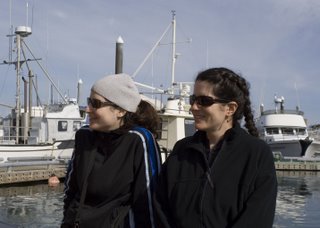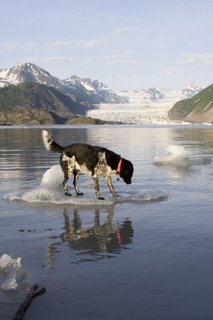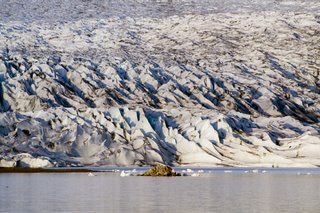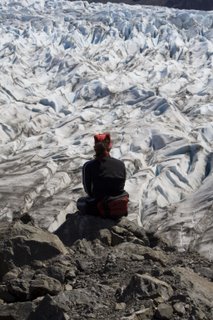This year’s race was better for me for so many reasons. Chiefly, it was great to run the race with Andrea and experience it with her. It was great to feel as good as I did through the whole race - all the way until the end my body felt like it was well trained and fast. (This was a sharp contrast to the torture of 2001.) Having run this race before helped so much in knowing what to expect during the race, and what to focus on in training.
A fast startThe last time I ran this race in 2001, I started way too fast. Call it early race excitement but I think I paid for my fast time up the pass with a total crash later in the race (more on that later). This year, Andrea and I did a practice run up the pass and I was pretty happy with our steady pace. But when the gun went off on Saturday, whew, Andrea blew out of the gates fast. (I think she already had the best-amateur title in mind!) At least it was fast for me - I was working to keep up with her. At one point I thought I would ask her to slow down but the run up takes so much concentration I didn’t want to break hers and I just concentrated on keeping my own pace steady. I ran within my limits.
About half-way up the pass, as most people’s running turned to power hiking, I passed Andrea and set the pace the rest of the way, getting to the check-point about a minute in front of her. I felt better and was relieved I didn’t put myself into too much of a deficit too early in the race. As people have pointed out, you can’t win the race on the climb up the pass, but it’s a great place to lose it.
Cruising the middle milesWe kept a solid pace on the decent. I waited for Andrea a few times on some of the more technical scree sections (and snow). It was illuminating to take a step, literally, out of the race and just watch people go by. It put things in perspective and helped my get in better touch with how my body was feeling.
The section between the top of the pass and the river is one of the most beautiful and challenging of the whole course. It's a relief to have reached the top within the time limit (and in one piece) and you are so elated at the expanse of downhill in front of you, you just want to start eating up the miles. And we did just that, keeping a swift pace through the deep brush, and passing a few small groups along the way. The views of the Raven and Eagle Glacier
It was important to eat in this section. As Chester said, the calories consumed in the second hour would pay off "compound interest" later in the race. I was trying to keep to my schedule of 300 calories an hour but I kept losing track of how much I had eaten. (I solved this problem by erring on the side of eating too much.) Andrea's stomach cramp prevented her from eating at this point, which may have hurt her later on.
I had hoped to reach the river (the half-way mark) around 2 hours - putting us on pace for a 4 hour finish. We reached it at about 2:15 - I wasn’t too worried though, the second half of the race was flat and we could still finish it in 2 hours. But when we reached the other side of the river, I could see Andrea was losing it. I knew exactly what she was feeling as I had been there myself in 2001. For some reason, the river crossing can be so demoralizing. I don’t know if it’s the cold, the wetness, or just the realization that the big downhill is over and you still have 13 rolling miles to run. But I cracked big at the river in 2001 - watching my friends slowly run into the distance as I let at 20 minute gap open up.
Andrea told me to just go, not to worry about her. I knew this wouldn’t work though, she was feeling sorry for herself and needed some tough love! It took about 3 miles of hectoring and pushing to finally get her pace up, but passing a large group in a particularly technical section renewed her spirits and got her up to pace. Every once in awhile she would mention some kind of pain and my standard response was keep running:
"I have a stomach cramp," "Well, let’s just keep running and see how it feels;" "Ouch, leg cramp! How do I get rid of it?," The best thing is to keep running;" "Did you see I fell?," "Yeah, I saw the blood," "No, I fell AGAIN, on BOTH KNEES," "Keep running."
So not exactly compassionate but it got the job done and she finished great.
The finishWith about 1.5 miles to go, Andrea and I caught up with Chester (he had ran ahead somewhere around 3 miles to go). We ran together for a bit then split up for the finish. I had quite a bit left in the tank at the end and I tried to make it to the line in under 4:30 (I came close at 4:30:14). I finished really strong and passed 4 people in the last mile. That really feels good at the end of a race this long. This was a great learning experience. I learned how important it is to run a race like this multiple times to get a "feel" for the course before getting too upset about a bad finishing time. I beat my previous time by 26 minutes and felt really good at the end (as opposed to last time when I walked into the finish). Next year maybe we will finish closer to 4 flat? Who knows, but at least we will know what we are in for.




 On Sunday we hiked to the glacier via a rather circuitous and long (roughly 15 miles RT) route.
On Sunday we hiked to the glacier via a rather circuitous and long (roughly 15 miles RT) route.  To cross the Grewingk river, we used the hand tram, which is a very cool contraption, just tough on the arm muscles. Most of the trail was below treeline, but the payoff was awesome -- Debbie and I ventured down and touched the glacier, saw the water rushing through the ice itself, carving it into little cubes, and saw little pools of water forming below the glacier.
To cross the Grewingk river, we used the hand tram, which is a very cool contraption, just tough on the arm muscles. Most of the trail was below treeline, but the payoff was awesome -- Debbie and I ventured down and touched the glacier, saw the water rushing through the ice itself, carving it into little cubes, and saw little pools of water forming below the glacier.  On the way back, we took a rather adventurous route (we naively thought we could cross the river w/o the help of the hand tram) and ended up bushwacking about a mile through solid bear habitat. Singing every campy, folksy song we could think of, we safely made it back to the trail and to camp.
On the way back, we took a rather adventurous route (we naively thought we could cross the river w/o the help of the hand tram) and ended up bushwacking about a mile through solid bear habitat. Singing every campy, folksy song we could think of, we safely made it back to the trail and to camp.